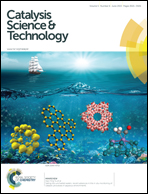Optimization of the catalytic hydrogenation of terebinth by a Ni-based catalyst
Abstract
Cumulative amounts of waste equilibrium fluid catalytic cracking catalyst (Ecat) are generated in the petrochemical industry every year. They are contaminated by toxic heavy metal ions, and are dumped into landfills, posing difficulties in solid waste management and resulting in severe environmental problems as well as resource waste. Thus, using Ecat as a support, a new non-noble metal supported Ni catalyst (Ni/Ecat) was synthesized and applied to convert terebinth, a renewable feedstock, into value-added pinane. The catalyst was characterized by SEM, XRD, FTIR and TPR. In the hydrogenation process, important variables like temperature, pressure, reaction time and stirring speed have been studied by response surface methodology (RSM). The optimum reaction time, temperature, hydrogen pressure, and stirring speed were found to be 2.3 h, 110 °C, 3.2 MPa and 540 rpm, respectively, with conversion of terebinth of 98.90% and selectivity of cis-pinane of 94.00%. This result clearly showed that Ni/Ecat exhibited high activity, selectivity and good stability. The Ni/Ecat can be reused 13 times with terebinth conversion of 93.73% and selectivity of cis-pinane of 93.60%.


 Please wait while we load your content...
Please wait while we load your content...